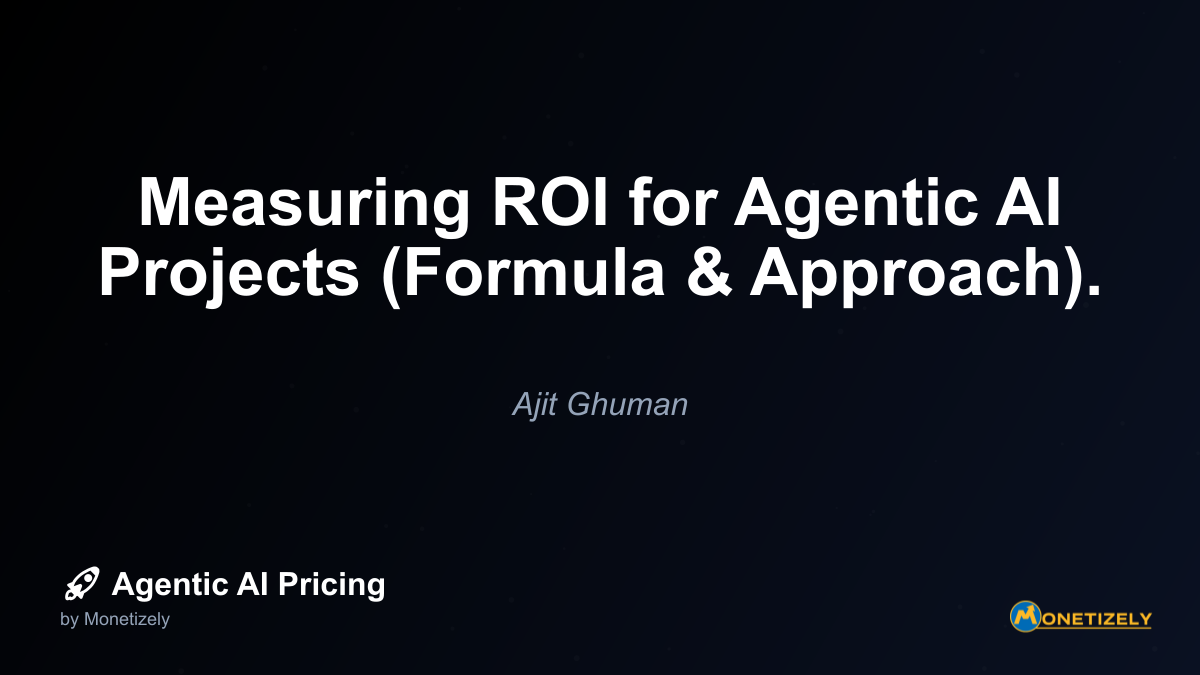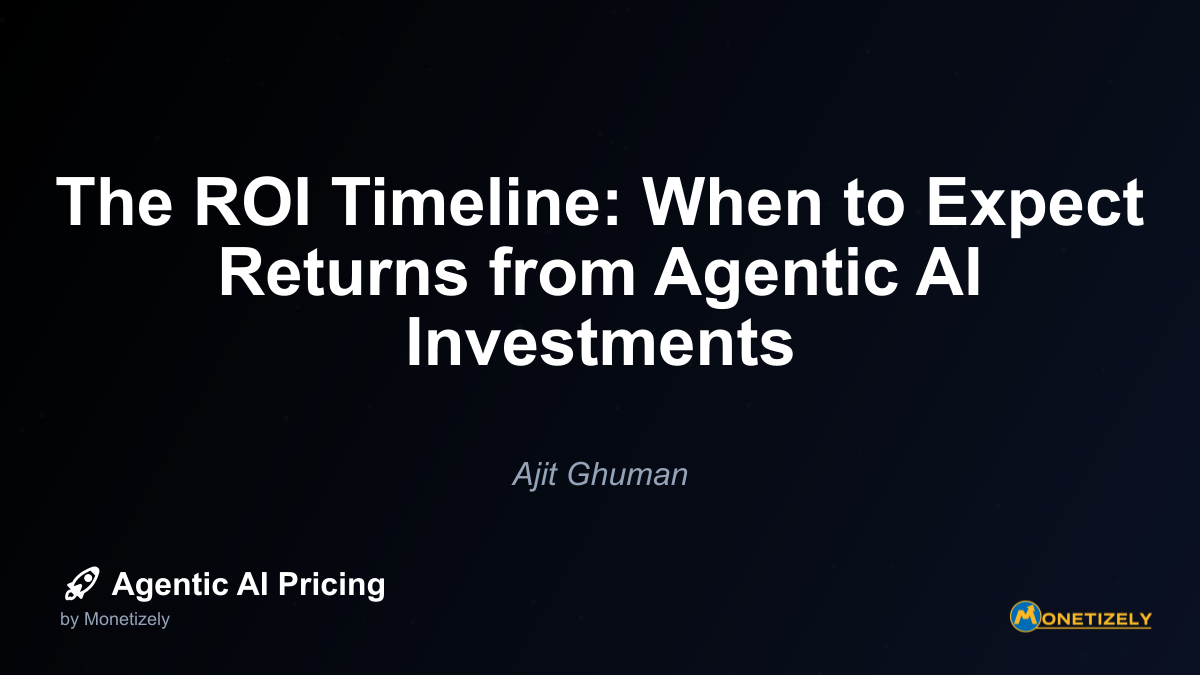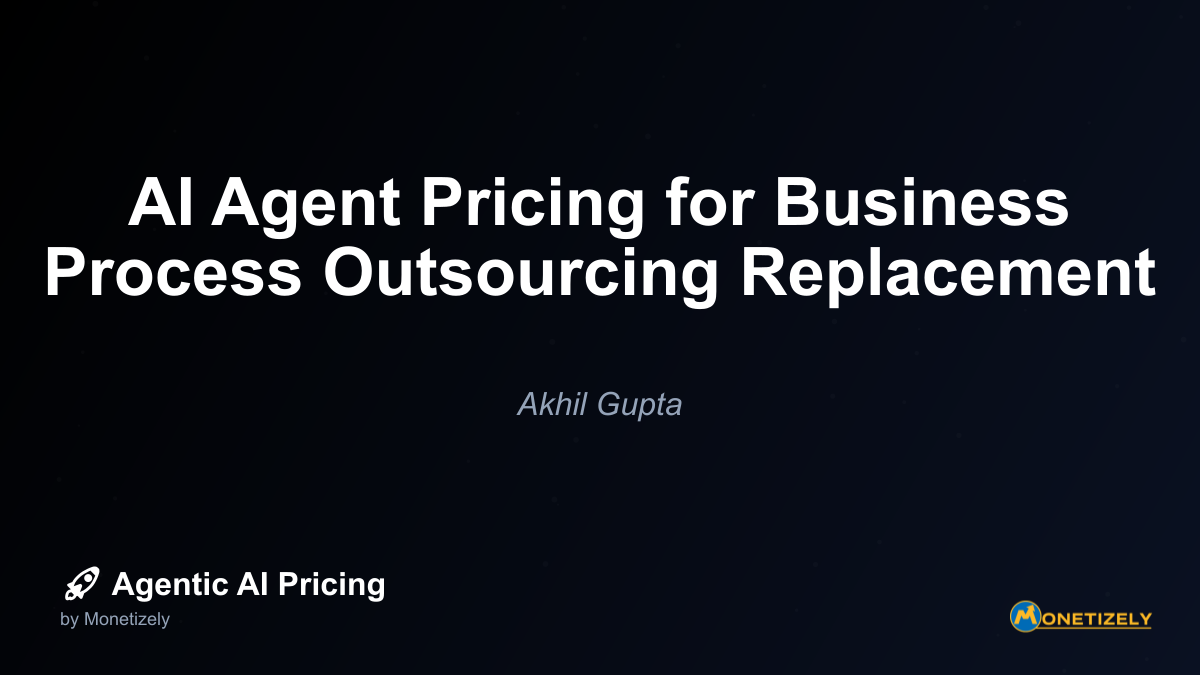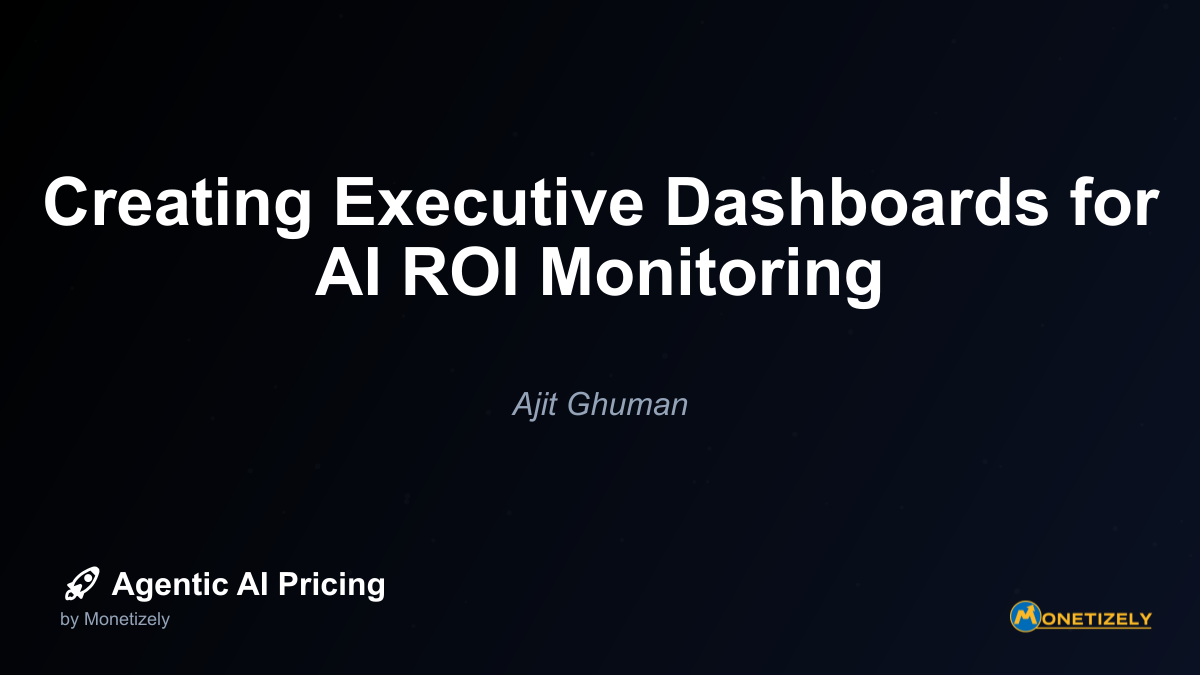· Akhil Gupta · ROI and Value · 9 min read
ROI Case Study Highlights: Achieving 3-8x Returns with AI.
AI and SaaS Pricing Masterclass
Learn the art of strategic pricing directly from industry experts. Our comprehensive course provides frameworks and methodologies for optimizing your pricing strategy in the evolving AI landscape. Earn a professional certification that can be imported directly to your LinkedIn profile.
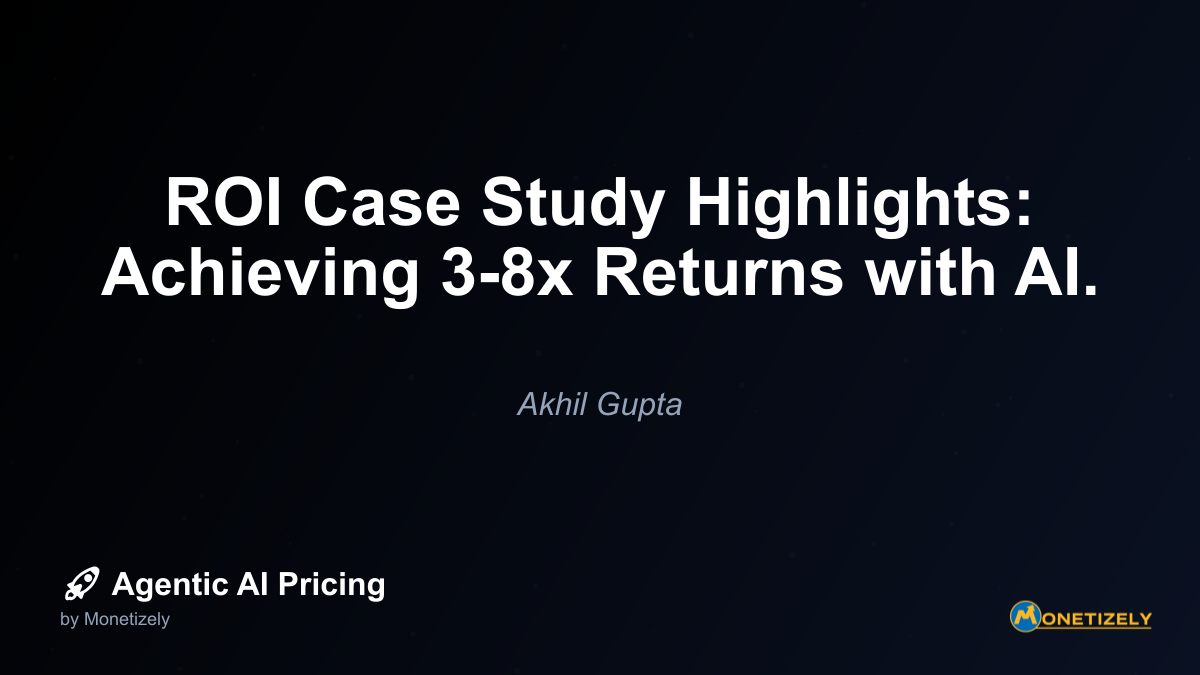
In an increasingly competitive business landscape, companies are seeking technologies that deliver measurable returns on investment. Agentic AI—autonomous AI systems that can perform complex tasks with minimal human supervision—has emerged as a powerful tool for organizations looking to drive significant business value. While the initial investment in agentic AI solutions can be substantial, forward-thinking companies are reporting impressive returns, often ranging from 3x to 8x their initial investment.
This article examines several compelling case studies that demonstrate how organizations across various industries have leveraged agentic AI to achieve remarkable ROI. By understanding the strategies, implementation approaches, and value drivers behind these success stories, business leaders can better position their own AI initiatives for maximum impact.
The ROI Imperative: Why Measuring AI Returns Matters
Before diving into specific case studies, it’s important to understand why ROI calculations for agentic AI deployments are crucial. Unlike traditional IT investments, AI initiatives often deliver value through multiple channels simultaneously—increasing revenue, reducing costs, improving efficiency, enhancing customer experiences, and enabling innovation.
According to recent industry research, companies that implement robust ROI measurement frameworks for their AI initiatives are 2.3 times more likely to achieve their expected returns than those that don’t. This is because clear ROI metrics help organizations:
- Prioritize AI use cases with the highest potential impact
- Secure continued executive support and funding
- Refine implementation strategies based on performance data
- Scale successful pilots across the enterprise
- Justify additional AI investments
With that foundation established, let’s examine how several organizations have achieved exceptional returns from their agentic AI investments.
Case Study 1: Financial Services Firm Achieves 7.5x ROI Through AI-Powered Risk Assessment
A global financial services provider was struggling with inefficient risk assessment processes that were both time-consuming and prone to human error. The company invested $3.2 million in an agentic AI solution designed to transform their approach to risk management.
The Implementation
The AI system was deployed to:
- Analyze vast quantities of structured and unstructured data from multiple sources
- Identify potential risk factors that human analysts might miss
- Automate routine risk assessments while flagging complex cases for human review
- Continuously learn and improve based on outcomes and feedback
The Results
Within 18 months of deployment, the company reported:
- 68% reduction in false positives, allowing analysts to focus on genuine risks
- 42% faster assessment completion times
- 91% increase in early detection of potential fraud cases
- $24 million in prevented losses from improved risk identification
- $4.1 million in operational cost savings from efficiency improvements
The total value created—combining direct cost savings and prevented losses—represented a 7.5x return on the initial investment. Perhaps most importantly, the system continues to improve over time, suggesting the long-term ROI will be even higher.
Case Study 2: Manufacturing Company Realizes 5.2x ROI Through Predictive Maintenance
A mid-sized industrial manufacturer was experiencing significant production losses due to equipment downtime. Maintenance was primarily reactive or based on fixed schedules, resulting in either unnecessary maintenance or unexpected failures.
The company invested $2.8 million in an agentic AI solution for predictive maintenance across their production facilities.
The Implementation
The AI system incorporated:
- IoT sensors across critical production equipment
- Real-time data collection and analysis capabilities
- Machine learning models to predict potential failures before they occurred
- Autonomous scheduling of maintenance activities based on predicted needs
- Continuous optimization of maintenance protocols based on outcomes
The Results
After 24 months of operation, the manufacturer documented:
- 83% reduction in unplanned downtime
- 47% decrease in maintenance costs
- 31% extension of equipment lifespan
- 22% improvement in overall equipment effectiveness (OEE)
- $14.6 million in combined savings and productivity gains
This represented a 5.2x ROI on their initial investment. The company has since expanded the solution to additional facilities and is exploring other applications of agentic AI in their operations.
Case Study 3: Healthcare Provider Achieves 3.8x ROI Through AI-Enhanced Patient Care
A large healthcare network was facing challenges with patient scheduling, care coordination, and administrative workload. The organization invested $5.1 million in an agentic AI platform designed to streamline operations and improve care delivery.
The Implementation
The AI solution was deployed to:
- Optimize patient scheduling based on multiple factors (urgency, provider availability, patient preferences)
- Automate routine administrative tasks and documentation
- Provide decision support for care teams
- Identify potential gaps in care or follow-up needs
- Facilitate better coordination across departments
The Results
Within the first year, the healthcare provider documented:
- 34% reduction in administrative workload for clinical staff
- 27% decrease in appointment no-shows
- 41% improvement in appropriate care pathway adherence
- 19% increase in patient satisfaction scores
- $19.4 million in combined cost savings and revenue improvements
The 3.8x ROI was considered exceptional in the healthcare sector, where technology implementations often struggle to deliver measurable financial returns. The organization has since expanded the AI platform to include additional capabilities focused on preventive care and population health management.
Case Study 4: Retail Chain Secures 8.3x ROI Through AI-Driven Customer Experience
A national retail chain with both physical and online stores was losing market share to more digitally savvy competitors. The company invested $4.7 million in an agentic AI solution focused on personalizing customer experiences and optimizing inventory management.
The Implementation
The AI platform was implemented to:
- Create hyper-personalized shopping experiences across all channels
- Dynamically adjust pricing and promotions based on multiple factors
- Optimize inventory allocation across the store network
- Automate customer service interactions through intelligent chatbots
- Predict emerging customer trends and preferences
The Results
After 18 months, the retailer reported:
- 28% increase in online conversion rates
- 17% growth in average order value
- 32% reduction in excess inventory
- 41% decrease in customer service costs
- 23% improvement in customer retention rates
- $39 million in additional revenue and cost savings
This represented an impressive 8.3x ROI on their initial investment, making it one of the most successful digital transformation initiatives in the company’s history. The retailer is now expanding its use of agentic AI into supply chain optimization and store operations.
Key Success Factors in High-ROI AI Implementations
Analyzing these case studies reveals several common factors that contributed to their exceptional returns:
1. Clear Business Problem Focus
Each organization began with a well-defined business problem rather than implementing AI for its own sake. The technology was deployed specifically to address pain points with measurable financial impact.
2. Comprehensive Value Tracking
Successful organizations tracked both direct and indirect benefits of their AI implementations. This included obvious metrics like cost savings and revenue increases, but also second-order effects like improved employee satisfaction and customer retention.
3. Iterative Implementation Approach
Rather than attempting a “big bang” deployment, these companies started with focused pilot projects, demonstrated value, and then expanded incrementally. This approach reduced risk and allowed for continuous refinement.
4. Strong Change Management
Each case study involved significant attention to human factors and change management. Employees were properly trained, processes were redesigned to leverage AI capabilities, and leadership actively championed the initiatives.
5. Technical-Business Collaboration
Cross-functional teams that combined technical expertise with deep business domain knowledge were critical to success. These teams ensured the AI solutions addressed real business needs in practical ways.
Common Challenges and How They Were Overcome
Despite their ultimate success, these high-ROI implementations faced several common challenges:
Data Quality and Integration Issues
Challenge: Incomplete, inconsistent, or siloed data limited the AI’s effectiveness initially.
Solution: Organizations invested in data preparation, cleansing, and integration before scaling their AI initiatives. They also implemented data governance frameworks to ensure ongoing data quality.
Resistance to Change
Challenge: Employees were concerned about job displacement or reluctant to trust AI-generated insights.
Solution: Successful companies focused on augmenting rather than replacing human workers, involved employees in the development process, and provided extensive training and support.
Difficulty Measuring Full Impact
Challenge: Traditional ROI calculations often missed important but less tangible benefits of AI implementations.
Solution: Organizations developed comprehensive measurement frameworks that captured both direct financial impacts and indirect benefits like improved decision quality and employee experience.
Technical Complexity
Challenge: Integration with legacy systems and maintaining AI performance over time proved challenging.
Solution: Companies invested in proper technical infrastructure, established clear ownership for ongoing maintenance, and created feedback mechanisms to continuously improve their AI systems.
How to Calculate AI ROI in Your Organization
Based on the approaches used in these case studies, here’s a framework for calculating ROI for agentic AI initiatives:
1. Establish Clear Baselines
Document current performance metrics before AI implementation, including:
- Process costs and cycle times
- Error rates and quality measures
- Resource utilization rates
- Revenue and margin figures
- Customer satisfaction and retention metrics
2. Identify All Value Drivers
Map all potential sources of value from the AI implementation:
- Direct cost savings (labor, materials, etc.)
- Revenue increases (higher conversion, larger orders, etc.)
- Risk reduction (fewer errors, better compliance, etc.)
- Time savings and productivity improvements
- Customer experience enhancements
- New capabilities and innovation potential
3. Track Implementation Costs
Document all costs associated with the AI initiative:
- Technology acquisition and licensing
- Implementation services and customization
- Data preparation and integration
- Infrastructure upgrades
- Training and change management
- Ongoing maintenance and support
4. Calculate Multiple ROI Perspectives
Develop ROI calculations that provide different views of value:
- Financial ROI (direct monetary returns)
- Strategic ROI (competitive advantage, market positioning)
- Operational ROI (efficiency and quality improvements)
- Customer ROI (experience and loyalty enhancements)
- Innovation ROI (new capabilities and opportunities)
5. Implement Continuous Measurement
Establish ongoing monitoring of value realization:
- Regular reporting on key performance indicators
- Periodic reassessment of baseline comparisons
- Feedback loops to improve AI performance
- Documentation of unexpected benefits or challenges
Preparing Your Organization for High-ROI AI Implementation
If you’re inspired by these case studies and want to achieve similar results in your organization, consider these preparatory steps:
1. Conduct an AI Opportunity Assessment
Evaluate your business processes to identify areas where agentic AI could deliver significant value. Prioritize opportunities based on potential impact, implementation complexity, and strategic alignment.
2. Develop an AI Value Framework
Create a comprehensive approach to measuring and tracking the value of AI initiatives in your organization. This should include both financial and non-financial metrics tailored to your industry and strategic objectives.
3. Build AI Literacy
Invest in developing AI understanding at all levels of the organization. Leaders need sufficient knowledge to make informed decisions, while teams need appropriate technical and application expertise.
4. Create a Data Strategy
Assess your current data assets and develop a plan to address any gaps. This includes data collection, integration, quality, governance, and security considerations.
5. Start Small but Think Big
Begin with focused pilot projects that can demonstrate value quickly, but develop these within the context of a broader AI strategy. This approach balances the need for early wins with long-term transformation.
Conclusion: The Path to Exceptional AI Returns
The case studies presented here demonstrate that exceptional ROI from agentic AI investments—ranging from 3x to 8x—is achievable across diverse industries. While these results are not guaranteed, organizations that approach AI implementation strategically, with clear business objectives and comprehensive measurement frameworks, are well-positioned to realize similar returns.
As agentic AI technologies continue to mature, the potential for high-ROI implementations will likely increase. However, the fundamental success factors will remain consistent: focus on well-defined business problems, invest in proper implementation and change management, measure comprehensively, and continuously refine your approach based on results.
By learning from these success stories and applying their lessons to your own AI initiatives, you can position your organization to achieve the remarkable returns that agentic AI can deliver when properly implemented and managed.
Co-Founder & COO
Akhil is an Engineering leader with over 16+ years of experience in building, managing and scaling web-scale, high throughput enterprise applications and teams. He has worked with and led technology teams at FabAlley, BuildSupply and Healthians. He is a graduate from Delhi College of Engineering and UC Berkeley certified CTO.
Pricing Strategy Audit
Let our experts analyze your current pricing strategy and identify opportunities for improvement. Our data-driven assessment will help you unlock untapped revenue potential and optimize your AI pricing approach.

